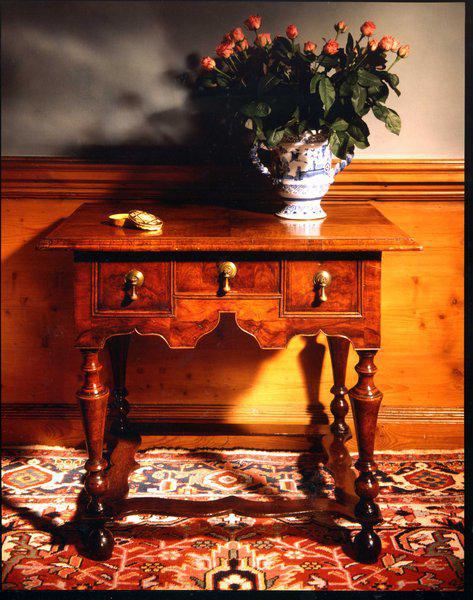A rare, late-17th century walnut-veneered dressing table
10387
The plank top with quarter veneers, herringbone inlays and a moulded edge with minor repairs. The shaped, frieze faced with cockbeading and three small, drawers, with minor repairs to herringbone inlay, original handles and double-bead facing. The shaped, sides solid walnut. Standing on trumpet turned legs joined by shaped front and side stretchers and a straight back stretcher. Standing on later bun feet. Excellent configuration, original colour and patina. The carcass oak and pine. English, fourth quarter of the 17th century.
5107931.
This is a particularly fine, and rare, early example of a lady's dressing table with exceptional original colour and patina.
After the Restoration, elaborate sets of dressing plate became fashionable for the wealthy. These must have required a substantial table for their display in order to accommodate a mirror supported on a strut, salvers, porringers for possets, candlesticks, powder boxes, caskets, brushes and combs. Towards the end of the 17th century painting and rougeing the face was indulged in to an enormous extent and deaths occurred from the immoderate use of paints and powders containing deleterious ingredients such as mercury and white lead. Henry Savile writing to the Marquess of Halifax in 1686, records the death of Lady Wentworth, who 'sacrificed her life for her beauty, by painting so beyond all measure that the mercury got into her nerves and killed her'.
It became the custom for ladies of fashion to sit at a dressing-table giving the finishing touches to their face and hair. Representations in pictures and engravings of this time show that many dressing-tables were completely enveloped in fringed draperies, and had elaborately worked covers. The walnut and japanned swing toilet glasses on box stands that came into fashion circa 1700 were placed on small veneered walnut tables with pillar or cabriole legs and usually two or three deep drawers to hold brushes, combs etc.
17th Century
1675
Walnut
England







